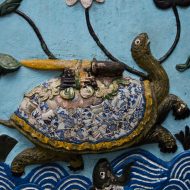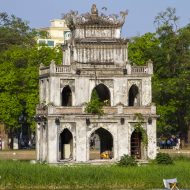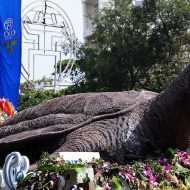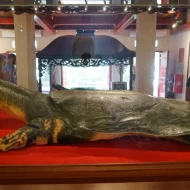Rua : The Golden Turtle
Listen
At a glance
| Description | |
|---|---|
| Origin | Vietnamese Mythology |
| Classification | Animals |
| Family Members | N/A |
| Region | Vietnam |
| Associated With | Protection, Independence |
Rua
Introduction
The turtle, known as Rua, occupies a notable position in Vietnamese culture and history, symbolizing longevity, strength, and intelligence. Additionally, the turtle is intricately linked to Vietnam’s quest for independence during the 15th century. Rua, as a symbolic creature, goes beyond temporal boundaries, encapsulating the profound wisdom of Vietnamese folklore and embodying the enduring spirit of the nation.
Physical Traits
While Vietnamese mythology does not explicitly detail the physical traits of Rua, being a turtle suggests that it likely shares typical turtle characteristics such as a tough shell, a modestly sized head, and four short legs. Depicted as a colossal turtle, Rua serves as a representation of strength, resilience, and longevity. Its shell, a formidable fortress adorned with intricate patterns, serves as a symbol of protection and stability.
In Vietnamese artistic representations, Rua is often shown carrying the weight of a mountain on its back, symbolizing the support it offers to the land. The deliberate and unhurried movements of this creature convey a profound sense of enduring patience and unwavering perseverance, qualities that resonate profoundly with the Vietnamese people.
Family
Vietnamese mythology does not provide explicit details about Rua’s family. Typically depicted in isolation, the turtle serves as a symbol of strength and wisdom. However, within the realm of Vietnamese mythology, Rua is frequently linked to the legend of the Golden Turtle God, known as Kim Qui. According to the narrative, Kim Qui emerged from the waters to present Emperor Le Loi with a magical sword, a crucial element in his triumph over the Ming invaders. This sacred connection between Rua and the Golden Turtle God establishes the creature’s familial ties to the spiritual realm.
Other names
The Vietnamese term for turtle is “rùa.” In certain narratives, it is also denoted as Cu Rua or Great Grandfather Turtle, underscoring its ancient lineage and its profound connection to the foundational roots of Vietnamese civilization.
Powers and Abilities
While Vietnamese mythology does not explicitly outline Rua’s powers and abilities, the turtle’s symbolism of longevity, strength, and intelligence strongly implies that it possesses these qualities. Additionally, Rua is connected to the historical figure Lê Lời, who led the Vietnamese against Chinese invaders in the 15th century, suggesting that the turtle may be perceived as a protector or a symbol of resistance and independence.
One of the most remarkable attributes attributed to Rua is its ability to transform into a humanoid form, enabling it to engage with humans and undertake divine tasks. Legends recount Rua’s role in bestowing magical objects and offering guidance to those in need, solidifying its reputation as a benevolent and wise entity.
Modern Day Influence
In present-day Vietnam, Rua maintains a cherished place in the hearts and minds of the population. The renowned Hoan Kiem Lake in Hanoi is the residence of a revered giant turtle, often regarded as the contemporary embodiment of Rua. This living legend, commonly known as Cu Rua, emerged as a symbol of hope and resilience, enduring for several decades before its passing in 2016. The demise of Cu Rua prompted a collective mourning, underscoring the profound cultural connection between the mythical turtle and the Vietnamese people.
Today, Rua persists as a symbol of longevity, strength, and intelligence within Vietnamese culture. The turtle’s link to the historical figure Lê Lời and Vietnam’s independence in the 15th century remains a resonant theme for the Vietnamese, serving as a poignant reminder of their rich history and the resilience of their forebears. The turtle frequently appears in Vietnamese art and literature, a testament to its enduring influence on the cultural landscape of Vietnam.
Related Images
Frequently Asked Questions
What is lorem Ipsum?
I am text block. Click edit button to change this text. Lorem ipsum dolor sit amet, consectetur adipiscing elit. Ut elit tellus, luctus nec ullamcorper mattis, pulvinar dapibus leo.
What is lorem Ipsum?
I am text block. Click edit button to change this text. Lorem ipsum dolor sit amet, consectetur adipiscing elit. Ut elit tellus, luctus nec ullamcorper mattis, pulvinar dapibus leo.
What is lorem Ipsum?
I am text block. Click edit button to change this text. Lorem ipsum dolor sit amet, consectetur adipiscing elit. Ut elit tellus, luctus nec ullamcorper mattis, pulvinar dapibus leo.
What is lorem Ipsum?
I am text block. Click edit button to change this text. Lorem ipsum dolor sit amet, consectetur adipiscing elit. Ut elit tellus, luctus nec ullamcorper mattis, pulvinar dapibus leo.
What is lorem Ipsum?
I am text block. Click edit button to change this text. Lorem ipsum dolor sit amet, consectetur adipiscing elit. Ut elit tellus, luctus nec ullamcorper mattis, pulvinar dapibus leo.







